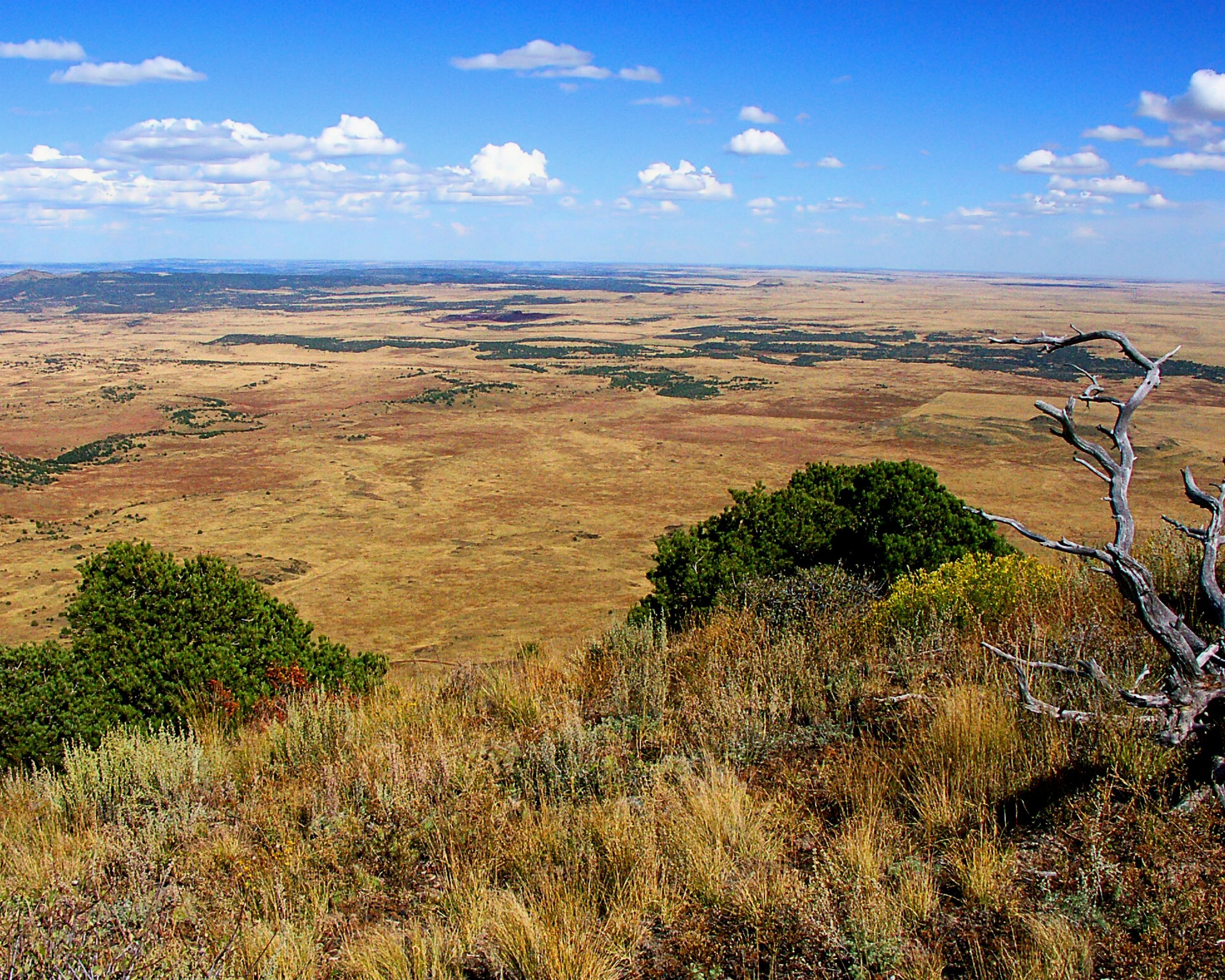View from top of Capulin Volcano National Monument, Union County
Pre-Contact Territory: eastern New Mexico, southeastern Colorado, southwestern Kansas, western Oklahoma, and northwest Texas
Current Location: Lawton, Oklahoma
Current Population: 15,000
Language: The Comanche language is in the Uto-Aztecan family, along with Hopi.

Click to expand
Traditional Homelands
Language Family

The Comanche were a nomadic hunter gatherers that originally lived in the Rocky Mountains then moved out onto the Plains in Colorado, Oklahoma, New Mexico, Texas, and Kansas.
After the Pueblo Revolt, the Pueblos started a lucrative horse trade. Horses are not native to the Americas and so their introduction to the Plains was a revolutionary moment. It gave these tribes immediate huge advantages. They could travel great distances, engage in more extensive trade, hunt, and wage war. The Comanche soon ranged a territory from Canada to Mexico. They grew to be the dominant tribe and have been called the most powerful tribe in history. At one point there were around 40,000 Comanche.
When the Comanche took captives during wars with other tribes, they would often sell them as slaves to the Spanish and Mexican settlers. They also took thousands of captives from the settlers. "Comanche" is from the Ute name for them, kɨmantsi , which means “enemy".
Shortly after Mexico liberated itself from Spain, Comanche war bands pushed into the newly independent, war-weakened country. They forged war trails a thousand miles long that moved through Mexico’s deserts, mountains, and jungles. Comanche warriors raided cities within a mere three-day ride of Mexico City itself.
Language
The Comanche language is a Numic language of the Uto-Aztecan family, sometimes classified as a Shoshone dialect. While it was the common language in the Great Plains in the 18th century, today only about 1% of Comanches speak their language.
It was always believed that the Comanche practiced leave-no-trace - where ever they made camp, they would make sure there was nothing left behind - largely to avoid being tracked. But the discovery of rock art at a Comanche camp in Taos County by Severin Fowles (who is doing work with the Picuris Pueblo) is causing archaeologists and the Comanche to revisit theories about the Comanche culture. (You can read the archaeology article here.)
This map shows a few of the many locations in New Mexico named for the Comanche.
FOUNDER OF NATIVE AMERICAN CHURCH MOVEMENT
Quanah Parker was a war leader of the Kwahadi ("Antelope") band of the Comanche Nation. His father was a Comanche chief and his mother was an Anglo woman who had been abducted at 9 years old and assimiliated into the tribe.
Quanah was appointed by the federal government as principal chief of the entire Comanche Nation. He became a primary emissary of southwest indigenous Americans to the United States legislature.
With the demise of the buffalo herds that sustained them along with their forced relocation to Oklahoma, the Comanche and Kiowa began leasing their land to cattle ranchers. Quanah became close friends with Samuel Burk Burnett and learned cattle ranching from him. It was through Burnett that Quanah became friends with President Roosevelt.
Quanah Parker is credited as one of the first important leaders of the Native American Church movement. After being gored by a bull, a Mexican curandera made him drink a strong peyote tea. (Clinical studies indicate that peyocactin, a water-soluble crystalline substance separated from an ethanol extract of the plant, proved an effective antibiotic against 18 strains of penicillin-resistant Staphylococcus aureus, several other bacteria, and a fungus.)
Peyote is an ancient medicine of the indigenous people in northern Mexico, but it was not a part of North American native culture until Quanah Parker advocated for it and founded the Native American Church. The NAC and the use of peyote spread to tribes throughout the United States and Canada because of Quanah’s advocacy.
Peyote is highly misunderstood and stigmatized by colonizers and Western culture. A search for research about peyote results in papers focused on drug abuse and hallucinogens. The U.S. Drug Enforcement Administration lists peyote as a Schedule I controlled substance and articles have been written about peyote being used recreationally - an assertion that is most likely false. This small cactus grows naturally in a very small area (between El Paso and Laredo, texas). Its harvest is highly regulated, with very few people being authorized to harvest the plant in the wild. The location of harvest is also regulated because it takes 10 years for the plant to mature.
For much of his life Quanah fought for the legal use of peyote in the movement's religious practices. This became a reality 83 years after his death when, in 1994, an ammendment was made to the American Indian Religious Freedom Act that grants the use of peyote for traditional ceremonial purposes with the Native American Church.







